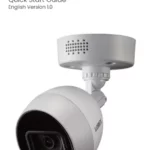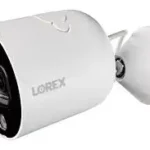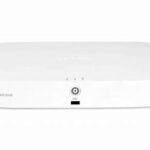

Lorex 4K Ultra HD Security DVR
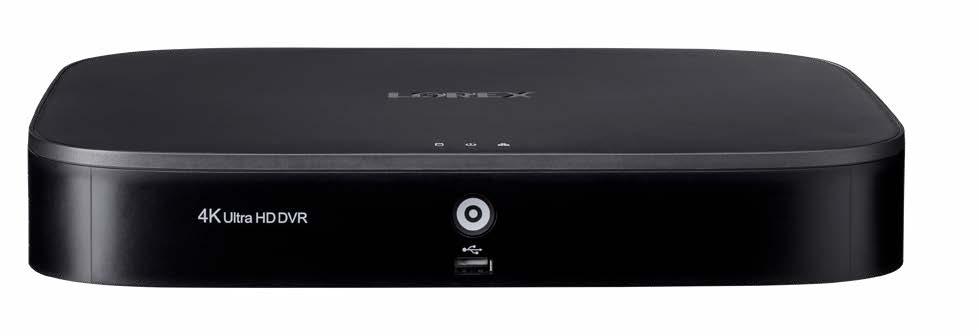
Lorex 4K Ultra HD Security DVR
D841 Series
Quick Setup Guide
Physical setup of the recorder and essential system settings
Package Contents

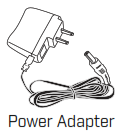
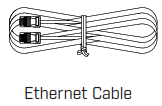

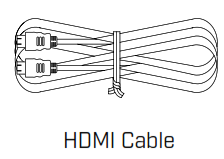
Dimensions


Setting Up Your Recorder
See the steps below (expanded instructions to the right) to complete initial setup of the recorder:
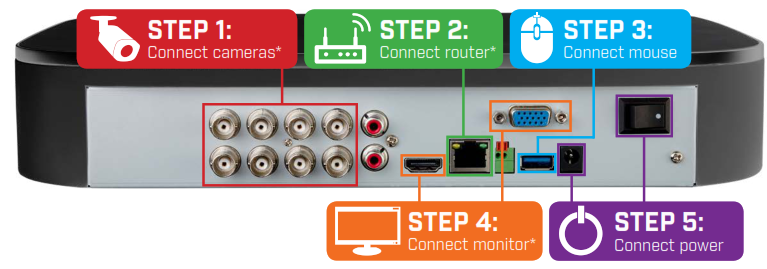
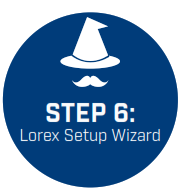
8-channel configuration shown. 16-channel will have the respective number of video inputs.
For camera compatibility information, visit lorex.com/compatibility.
* Not included / sold separately.
Overview of extra ports:
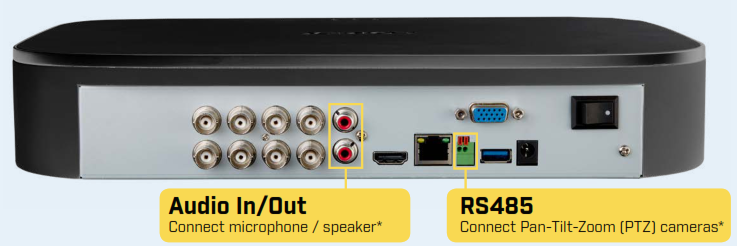
Need Help?
Visit us online for up-to-date software and complete instruction manuals.
- Visit lorex.com
- Search for the model number of your product
- Click on your product in the search results
- Click on the Downloads tab
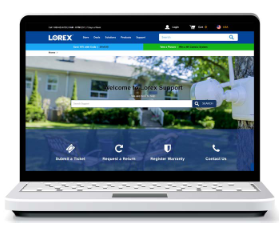
Copyright © 2019 Lorex Corporation
As our products are subject to continuous improvement, Lorex reserves the right to modify product design,
specifications and prices, without notice and without incurring any obligation. E&OE. All rights reserved.
D841B_QSG_EN_R
Back panels shown below are for illustration only. Your recorder’s back panel may appear different, with all the same ports in different locations.

Test your cameras prior to selecting a permanent mounting location by temporarily connecting the cameras and cables to your DVR.

NOTES:
- The extension cable must be a single stretch of cable between the recorder and camera. You cannot connect multiple extension cables to each other.
- This guide covers connecting cameras to your security recorder only. For full instructions on installing your cameras, please refer to your camera’s documentation at lorex.com.
- Before selecting a permanent mounting location for your cameras, see Ensuring Accurate Person and Vehicle Detection below for important camera installation notes.

Connect the recorder to your router using the included Ethernet cable.

NOTE: To receive automatic firmware updates and enable remote viewing with mobile apps, a high speed Internet connection is required (minimum upload speed of 5Mbps required for 4K viewing; 3.5Mbps for lower resolutions). All other system features can be used without an Internet connection.

Connect the included mouse to a USB port on the recorder.


Connect the recorder to a monitor using the included HDMI cable or a VGA cable (not included). The HDMI port supports up to 4K resolution, and VGA supports up to 1080p.

IMPORTANT: The system will automatically match the resolution of the connected monitor the first time you use the recorder. If you need to switch monitors, make sure you set the recorder to an output resolution supported by the new monitor before switching. See Changing the Recorder’s Output Resolution on the rear for details.

Use the included power adapter to connect the recorder to a nearby outlet. Turn the recorder on using the power switch on the back panel.


When you first power up your recorder, the Lorex Setup Wizard will begin. The Wizard will help you configure core system settings.
You will also create a secure password. For future reference, it is recommended that you record yourpassword here:

Record your password below and store in a secure place:


The following are important camera installation notes to ensure accurate person and vehicle detection. For full camera mounting instructions, see your camera’s documentation at lorex.com.
- Angle the camera so that objects of interest appear in the bottom ⅔ of the camera image.
- Choose a location where objects of interest will be no further than 50ft (~15m) from the camera.

- Angle the camera between 30~60° down from the level position.
- Install the camera between 8-16ft (2.5-5m) off of the ground.
NOTE: Accuracy of person and vehicle detection will be influenced by multiple
factors, such as the object’s distance from the camera, the size of the
object, and the height and angle of the camera. Night vision will also impact
the accuracy of detection.
Additional Installation Tips:
- Point the camera where there is the least amount of obstructions (e.g., tree branches).
- Install the camera where vandals cannot easily reach.
- Secure cabling so that it is not exposed or easily cut.
- This camera is rated for outdoor use. Installation in a sheltered location is recommended.

Once you have completed all steps for initial setup on the front of this guide, please refer to the following sections to learn more about using your system.
Using the Mouse

NOTE: In live view, hover the mouse cursor over the top of the screen to open the Navigation Bar. Move the mouse cursor away from the top of the screen to close the Navigation Bar.
Quick Access to System Information
To quickly open a window that displays vital system information such as device ID, model number, firmware version, and IP address:
- Tap the button on the front panel of the recorder.
OR - Right-click to open the Quick Menu and click Info.
Using the Quick Menu
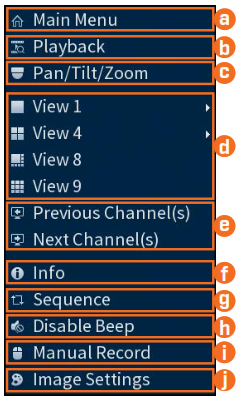
Right-click anywhere on the live viewing screen to open the Quick Menu.
a. Open Main Menu.
b. Search and playback recordings.
c. Control PTZ cameras (not included).
d. Select camera / live display view.
e. View previous / next channel(s).
f. View system information.
g. Start/stop sequence mode.
h. Temporarily disable all current audible warnings.
i. Open manual recording controls.
j. Adjust camera color and image settings.
Changing the Recorder’s Output Resolution
The system will automatically match the resolution of the connected monitor the first time you use the recorder.

To change the recorder’s output resolution:
- From live view, right-click and then click Main Menu. If prompted, log in using the system user name (default: admin) and your new, secure password.
- Click DISPLAY, then configure the following:
- Set Resolution to match the
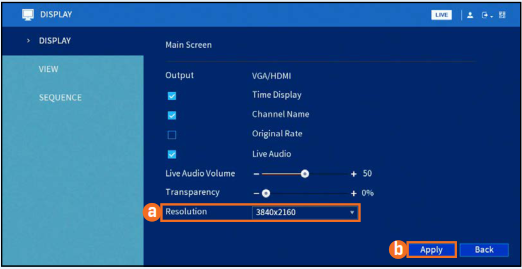
- Click Apply. The recorder will restart before changes take effect.
Playback
Search through and play video recordings from the hard drive.
To search for and play recordings:
- From live view, right-click and then click Playback. If prompted, log in using the system user name (default: admin) and your new, secure password.
- Configure the following:
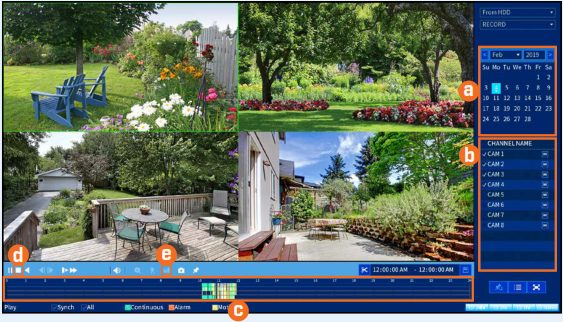
a. Use the calendar on the right to select the date to playback.
b. Check channels you want to play back. Click the icon beside each selected channel to select Mainstream (M) or Substream (S) video quality.
c. Click inside the video bar to select the playback time. Playback starts immediately at the selected time.
To filter for person / vehicle recordings:
PREREQUISITE: You must enable Smart Motion Detection on any and all channels you would like to filter for person / vehicle detection. See the section Motion & Advanced Person/Vehicle Detection for details.
d. Click 
e. Hover over the icon 
Backup
Back up recordings from the hard drive to a USB flash drive (not included).
To back up recordings:
- Insert a formatted USB flash drive (not included) into a free USB port on the recorder.
- From live view, right-click and then click Main Menu. If prompted, log in using the system user name (default: admin) and your new, secure password.
- Click BACKUP.
- Configure the following:
a. Select your USB drive and the folder for the backup.

b. Select the channel(s) and recording types to search by.
c. Select a start and end time.
d. Choose a file format.
e. Click Add to see recordings that match your search.
f. Check boxes next to recordings you want to back up.
g. Click Backup.
Motion and Advanced Person/Vehicle Detection
Set preferences for motion detection. This section includes setup of person/vehicle detection. By default, person/vehicle detection is enabled on channels 1-4.
To configure motion & advanced person/vehicle detection:
- From live view, right-click and then click Main Menu. If prompted, log in using the system user name (default: admin) and your new, secure password.
- Click ALARM. Click MOTION on the far-left, then click the Motion Detect tab.
- Configure the following:
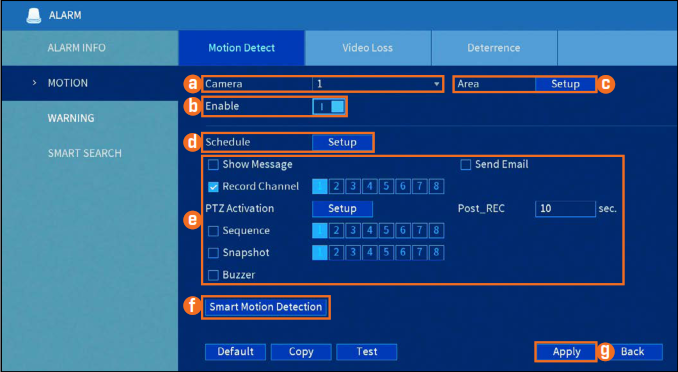
a. Select the channel you would like to configure.
b. Click Enable.
c. Click Setup next to Area to set an active area for motion detection. See Figure 1 below for details.
d. Click Setup next to Schedule to set the weekly schedule for motion detection. See Figure 2 below for details.
e. Set preferences for how the system reacts to motion detection events.
f. Click Smart Motion Detection to enable person / vehicle detection. See Figure 3 below for details.
g. Click Apply to save changes.
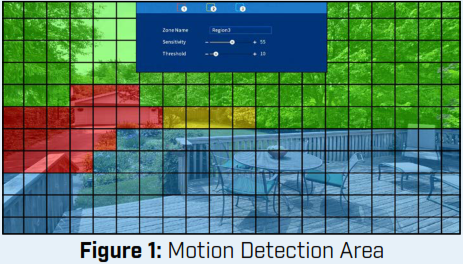
- The camera image appears with a red grid overlay. This means the entire image is enabled for motion detection.
- Click or click-and-drag to add / remove boxes from the active area. Cells that have been removed from the active area appear green.
- Hover near the top of the image to reveal zone selection. You can set up to 3 different zones with different sensitivity and threshold values.
- Right-click when finished.
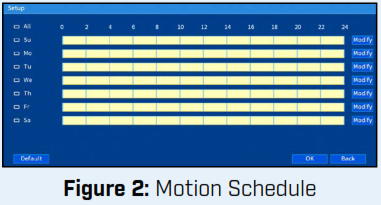
• The default schedule, shown in Figure 2, is active at all times.
• Click Modify to change the schedule for the corresponding day of the week.
• Click OK when finished.
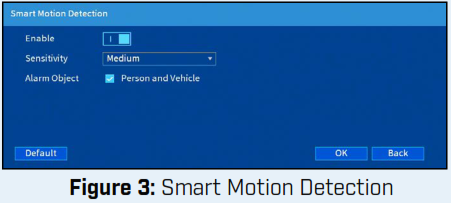
• Click Enable to allow detection of people and vehicles on the selected channel.
IMPORTANT: A maximum of 4 channels will support person/vehicle detection at once. By default, channels 1-4 have person/vehicle detection enabled.
- Select a Sensitivity level (a high sensitivity value will detect smaller objects than a low value).
- Check Person and Vehicle.
- Click OK when finished.
Configuring Deterrence Settings
Set preferences for automatic warning light triggering on compatible Lorex deterrence cameras. For a complete list of compatible deterrence cameras, navigate to your recorder series at lorex.com/compatibility.
To configure deterrence settings:
- In live view, right-click and click Main Menu. If prompted, log in using the system user name (default: admin) and your new, secure password.
- Click ALARM. Click MOTION on the far-left, then click the Deterrence tab.
- Configure the following:
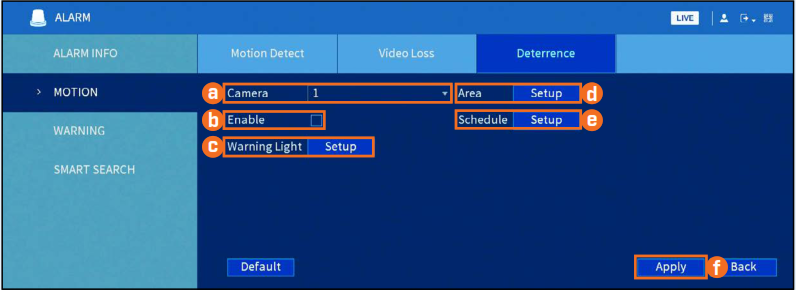
a. Select the channel of a connected deterrence camera.
b. Check Enable.
c. Click Setup next to Warning Light to configure preferences.
d. Click Setup next to Area to set an active area for automatic deterrence. See Figure 4 below for details.
e. Click Setup next to Schedule to set the weekly schedule for automatic deterrence. See Figure 5 below for details.
f. Click Apply.
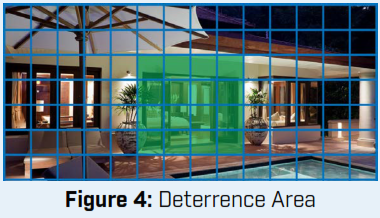
- The camera image appears with a grid overlay. The green area is the active area for deterrence.
- Click or click-and-drag to add / remove boxes from the active area.
- In Figure 4, only motion around the doorway will trigger warning light.
- Right-click when finished.
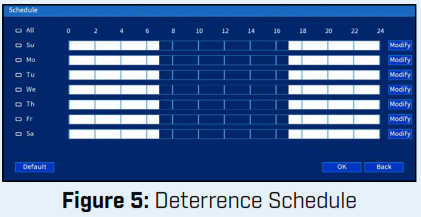
- The default schedule, shown in Figure 5, is active during the night, between 5pm and 7am.
- Click Modify to change the schedule for the corresponding day of the week.
- Click OK when finished.


FAQ’S
What is the difference between a 4K and 1080p security camera?
The main difference is resolution. 4K cameras have a higher resolution than 1080p cameras. For example, a 1080p camera has 1920 x 1080 pixels, while a 4K camera has 3840 x 2160 pixels.
What is the difference between H.264 and H.265?
H.264 is an older compression standard that is still supported by most devices. H.265, also known as HEVC, is newer and more efficient than H.264, so it can deliver video of the same quality at lower bitrates, making it easier to store and transmit video over networks with limited bandwidth.
Can I use any DVR with Lorex cameras?
All Viewtron IP cameras are ONVIF compliant which allows them to work with any ONVIF compliant recorder (DVR / NVR).
Can Lorex security cameras be hacked?
Any device connected to the internet can be hacked, and Lorex security cameras are no different. However, Lorex security cameras are relatively secure because all of the footage is stored locally on a hard drive instead of in cloud storage where hackers can access them.
Do Lorex cameras work without Internet?
Your Lorex Smart Home Security Center (LSHSC) does not need to be connected to Wi-Fi to function. This would be especially useful in the following scenarios: You don’t have an internet connection on your property but you still want to stay updated and record events.
What is difference between NVR and DVR?
A DVR converts analog footage into a digital format, while an NVR typically only works with digital footage. DVR systems process data at the recorder, while NVR systems encode and process data at the camera before transmitting it to the recorder for storage and remote viewing.
Does the orange dot mean someone is listening?
An orange indicator means the microphone is being used by an app on your iPhone. The orange dot wouldn’t indicate that since it is supposed to be on while you are on a call.
What happens when Lorex SD card is full?
when the SD card is full, and files will need to be manually deleted before new recordings can be stored.
How long do Lorex cameras keep footage?
The estimated recording time with a HDD of 2TB for 16 camera is around 1-2 days and 2-4 days for 8 cameras when using continuous recording. The unit can be set to record only when motion is detected however which greatly expands the recording time depending on the amount of motion events detected.
How do I view my Lorex recordings?
To view playback recordings using the Lorex Secure / FLIR Secure app:
Launch the Lorex Secure / FLIR Secure app on your smartphone or tablet.
On the Home screen, tap your camera to stream live video.
Tap the History icon to display all recorded events.
Scroll up / down to browse through all events.
Can you hear sound on Lorex cameras?
Select camera models include a built-in microphone that will capture the sounds around the camera. This can be a very handy feature that can add additional evidence (such as voices) and a greater ability to detect and interpret events, even if they occur off-screen.
How long does Lorex battery last?
These long-lasting, rechargeable lithium ion batteries can now power the cameras up to 8 months on a single charge.
